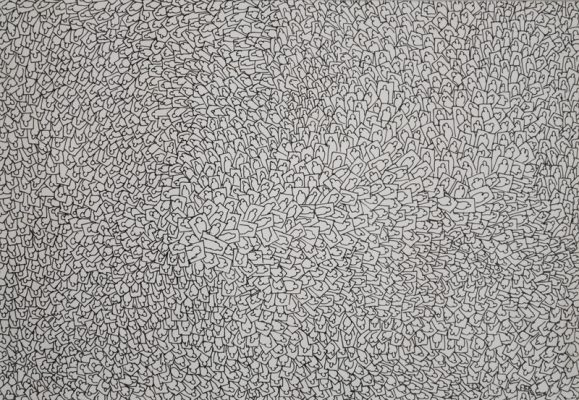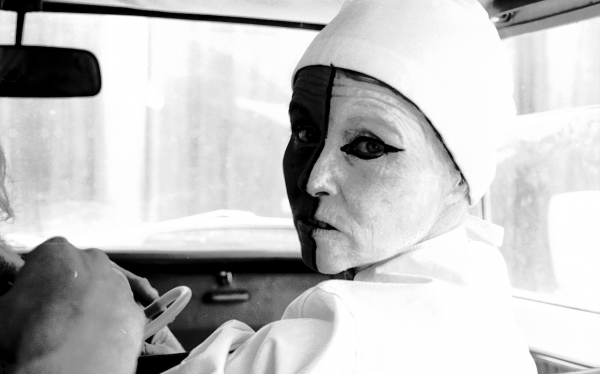In January, a preview excerpt in The New Yorker of Rachel Kushner’s essay collection The Hard Crowd (2021) warned us that this might turn out to be a boring book. This is not to say that the excerpt in question was so boring as to suggest the likely tedium of the whole. Rather, the warning came from the author herself. ‘I’m talking about my own life’, writes Kushner. ‘Which not only can’t matter to you, it might bore you.’
The Hard Crowd is indeed a personal collection – not only first-person in vantage but preoccupied with figures specific to the author’s youth: artists, writers, friends, activists, motorcyclists, hustlers. ‘I admired a lot of these people I am describing to you’, Kushner writes in the excerpted passage. They were workers of strip-club doors between prison stints, charismatic tattooists, dealers who preferred to eat their cocaine, nibbling sliced-off rocks ‘like powdery peanut brittle’. ‘I put them above myself’, she writes, ‘in a hierarchy that is re-established in the fact that I am the one who lived to tell’.
I was the weak link, the mind always at some remove: watching myself and other people, absorbing the events of their lives and mine. To be hard is to let things roll off you, to live in the present, to not dwell or worry. And even though I stayed out late, was committed to the end, some part of me had left early. To become a writer is to have left early no matter what time you got home.
Kushner, a writer in her fifties, appears to have outlived the fast-living crowd of her youth. Those who have typically delighted in her novels, populated by characters so ‘present’ as to have no future, might well anticipate boredom at the personal essays of so watchful a self-preserver. The Flamethrowers (2013), perhaps Kushner’s best-known work, is packaged as a Great American ode to rebellion and risk: blurb quotations describe the novel as ‘adrenalin-fuelled’, ‘exhilarating’, ‘fearless’, ‘high-octane’, ‘thrilling’. In 1970s New York, the book’s narrator Reno dreams of becoming the fastest motorcyclist in the world, and falls in with a cast of radicals from an Italian motorcycle company. ‘In an accident everything is simultaneous, sudden, irreversible’, Reno observes. ‘It means this: no going back.’ Commitment to speed, in Kushner’s world, is commitment to the force of life; death is its highest expression. In The Hard Crowd this tendency of Kushner’s is given something of an origin story. A child of beatniks, who came of age in 1980s San Francisco, she was taught by her parents that ‘real meaning lay with the most brightly alive people, those who were free to wreck themselves’.
The ideal, as it applies to Kushner, is limited to the collection’s first essay. Entitled ‘Girl on a Motorcycle’, the piece is adapted from an essay that appeared in the anthology She’s a Bad Motorcycle: Writers on Riding (2001), the first thing Kushner ever published. Here we find traces of a person as yet unsoftened by literary ambition, living, like the heroine of The Flamethrowers, fast enough to crash her bike at 130 mph. Even then, however, we are given a preview of her nascent writerly caution. The piece describes the Cabo 1000, an illegal motorcycle race across the Baja California Peninsula, in which a rogue motorcyclist named Sean once rode past a man after causing him to lose his leg on the edge of a cliff. Kushner lets us know that a few years later Sean himself would die in a similarly dangerous gamble. She, by comparison with him, is reasonably risk-averse. Competing alongside him in the same race in the late 1990s, Kushner swerves to avoid a guy who witlessly pulls out in front of her. Deliberating her safest option with a clarity made for retelling, she rides off the road and, crashing, suffers a sprain, some scabs and a rash. Afterwards, she bathes with her friends in the ocean as though it were a form of baptism. The rash loosens into writerly ‘streamers that sloughed off and trailed around me like seaweed’.
Still, the rogue reborn as writer runs no genuine risk of being boring. The Hard Crowd is not so much Kushner’s own memoir as a group biography of recklessness. Contained within her flippant self-construction-as-bore is in fact a claim on the exciting – a suggestion that the writer’s own softness is key to her accurate rendering of others’ hardness. Quoting Bob Dylan, who sang in 1965 that ‘He not busy being born is busy dying’, Kushner wagers that those most alive in their courting of death – the ‘hard crowd’ enthralled in the present – are still in a sense being born. As such, they are much too busy being born to absorb experience’s meaning, too ‘forever young’ to win the authority to speak for themselves:
You are busy being born the whole first long ascent of life, and then, after some apex, you are busy dying: that’s the logic of the line, its syntax, as I interpret. ‘Being born’ here is an open and existential category: the gaining of experience, a living intensely in the present, after which comes the long period of life when a person is finished with the new. This ‘dying’ doesn’t have to be negative. It too is an open and existential category of being: the age when the bulk of your experience, the succession of days lived in the present are mostly over. You turn reflective, interior, to examine and sort and tally.
Who better to narrate the lives of wrecked souls than the one who kept her head, storing up details of the wreckage? A flirtation with self-deprecation turns by a literary sleight of hand to a lofty self-appointment. Not boring after all but rather a vessel for excitement – the voice of a brood of Californian kids, a kind of Joan Didion for our times. The comparison with Didion is one that Kushner courts as much as rejects. In The Hard Crowd’s eponymous essay, written in 2020, digressing from an account of her own youth spent on the corner of Haight and Ashbury, Kushner addresses Didion’s unforgivable display of ignorance in the eponymous essay of her 1979 collection, The White Album. The subject of Kushner’s grievance is Jim Morrison’s trousers. ‘Dear Joan’, she writes, ‘Record albums are made out of vinyl. Jim Morrison’s pants were leather, and even a Sacramento debutante, a Berkeley Tri-Delt, should know the difference’. Yet we also learn off the back of this that Kushner herself attended Berkeley, and did so at the age of 16.
Both Kushner and Didion marked their own early entries into the realm of the ‘busy dying’ with disquisitions on San Franciscan youth. At 27, Didion felt she was no longer young in New York, that the golden rhythm had been broken since she now knew the names of all the bridges. A few years later she would document what she saw as the ‘social hemorrhaging’ apparent in the 1960s hippie culture in the Haight-Ashbury neighbourhood. Kushner in turn speaks of realising that the people and places she once knew would never be in books unless she wrote them. So, she explains, ‘I deputized myself World’s Leading Expert on ten square blocks of the Sunset District.’ The two writers exemplify a paradox of critical distance: those who are least ‘alive’ – busy looking, slowly parsing, not crashing but merely crawling towards death – are those most able to communicate ‘life’. ‘The expert’, writes Kushner, ‘absorbs what is “useful” for a person to remember.’
It is one thing for a writer of novels to claim expertise in permeability, another for an essayist to presume expertise in representing others. Didion seems at ease with what is troublesome here. ‘Writers’, she warns her readers in the introduction of the essay collection Slouching Towards Bethlehem (1968), ‘are always selling somebody out’. Her coldness of voice seems proper for a writer who ate and slept among her subjects without the slightest attempt to be ‘of’ them. Perched on the shoulder of a five-year-old child on acid, notebook in hand and literary ‘gold’ in her eyes, Didion locates a form of virtue in being ‘so physically small […] that people tend to forget that my presence runs counter to their best interests’.
Kushner, by contrast, is troubled by her role as interloper. In the essay ‘We Are Orphans Here’, she writes of visiting Shuafat refugee camp in East Jerusalem in 2016, and sitting across from a Palestinian child disfigured by fire. The child is one of many victims of a bus crash in which emergency services were delayed by confusion over who had jurisdiction:
I kept smiling at her, and she smiled back. I was desperate to give her something, to promise something. It’s very difficult to see a child who has suffered so tremendously. It’s basically unbearable. I should give her the ring I was wearing, I thought. But then I saw that it would never fit her fingers, which were very swollen and large, despite her young age; her development after the fire was thwarted because her bones could not properly grow. I’d give her my earrings, was my next idea, and then I realized that her ears had been burned off in the fire. I felt obscene.
The obscenity of Kushner’s distance from her subjects hovers unresolved over many of the essays in the The Hard Crowd. She writes of Thomas Wenger, a man who spent afternoons in the Blue Lamp bar where she worked in her youth. Wanting to infer meaning from this vacantly beautiful man, she presumes to find his blankness poignant: ‘he was obviously so wounded that he had to void himself by any means he could’. She only learns his full name when his face looks up at her one morning from the newspaper. His head had been found in a dumpster just a few blocks from the bar. ‘There are experiences that stay stubbornly resistant to knowledge or synthesis,’ Kushner writes. ‘I have never wanted to treat what happened to Thomas as material for fiction. It’s not subtle. It resists, like he did, comprehension.’
Kushner has form with latching discomfort to non-fiction writing. In a piece on Marguerite Duras, ‘Duras With An S’ (2017), she all but reaffirms Duras’s conviction that ‘the genre of autobiography [is] base, degraded. Same with “essayistic” writing’. ‘Literature,’ writes Kushner, ‘was her interest, that kind of truth.’ In an interview with Michael Silverblatt that followed publication of The Mars Room in 2018 – her novel set inside a women’s correctional facility in California – Kushner responded to the question of why she hadn’t just written a non-fiction book about prison. ‘I’m not a non-fiction writer,’ she protested. ‘I’m only receiving and trying to metabolise what I see without reducing it to a set of judgments.’ ‘I’m not interested’, she emphasised, ‘in telling people how they should live their lives.’
Yet despite this, The Hard Crowd includes an essay entitled ‘Is Prison Necessary?’, an extensive, meticulous piece on the purpose and politics of prison. The piece was written in the two years that followed that Mars Room interview, and sits alongside a mere fraction of Kushner’s considerable essayistic output. Why does this defensively fiction-bound writer continue to pursue so ‘degraded’ a literary form? Indeed, the problems of the form go deeper than mere didacticism, the minor offence of telling people how to live their lives. Rather than fabulating, as the novelist does, in order to conjure some impression of what life might be like ‘for a person such as x’, the variety of personal essayist who favours introspection courts two potential dangers: reducing others’ lives to what it feels like to look at them, or supposing that intellect can stand in for insight. The Hard Crowd is, in many ways, a gallery of lives precisely other than Kushner’s, even if they cohere around her own. It is her account of these lives we are invited to absorb, and the nature of this invitation becomes the writer’s central challenge. Kushner’s relations with her subjects have an air of ethical unevenness. Where her connection with a wounded child refugee starts with a vested interest – beginning with the intention to write – the child is rendered more of an instrument than, say, a friend who merely happens to be interesting.
Kushner’s strategy as an essayist, however – here is the real departure from Didion – is to grapple with precisely this problem. If Didion believes her reader is owed a modern journalistic document of history in the making, her concern, at whatever cost, is to honour this debt. Kushner is somewhat more interested in what she owes her subjects, and sees herself as part of the history-making process. In a 2017 reflection in the Boston Review on the value of personal essays, the scholar and critic Merve Emre, citing Didion’s intellectual dispassion, writes of the importance of a contract between reader and writer, one in which the terms must be mutually and clearly constructed if it is to be valid. Kushner’s explicit concern is the contract between writer and subject, on which this other contract depends. Presumably any deal with the object of contemplation ought to promise their depiction as a subject with both honesty and honest incompleteness. Kushner presents these contracts, these mutual relations, as part of her ‘streams of narrative life’, exposing their frequent disruption of fiction’s narrative beauty.
In the presence of Baha, the community organiser who acts as her guide to Shuafat, Kushner is rapt in collective ecstasy with the children who all adore him.
Later I told myself and everyone else how wonderful it was in the Shuafat camp. How safe I felt. How positive Baha was. All of that still feels true. But I also insisted, to myself and everyone else, that Baha never expressed any fears for his own safety. In looking at my notes, I see now that my insistence on this point was sheer will. A fiction. It’s right there in the notes. He said he was nervous. He said he’d been threatened.
‘We Are Orphans Here’ was written in the wake of Baha’s murder, 15 days after Kushner’s departure from the camp. Facts constraining the essay tug at the edges of the novelist’s vision, winching narrative set pieces into a place of relative disorder. Kushner diarises the struggle between the story she’d like to craft and the reality of a situation. Another thing she ‘suppresses’, but actually doesn’t, is Baha’s desire for police. ‘I didn’t write that down,’ she writes down, ‘It wasn’t part of my hero narrative, because the police are not part of my hero narrative.’
The essay ‘Is Prison Necessary?’ likewise performs a tussle between evidence, inference and emotion. It is a product not only of the process of writing The Mars Room, but also of Kushner’s personal investment in California’s carceral network. As a citizen-cum-writer, Kushner’s relation to the prison system splays in multiple directions, none of them (as if such a thing were possible) unproblematic. There are friends known since childhood whom she visits and supports, others encountered through advocacy and human-rights research. These relationships neither begin nor end with Kushner’s novel, yet of course it’s her name that is scrawled across the cover and listed on the Booker Prize shortlist. The essay, meanwhile, a feat of scrupulous research and deliberation, reads as an act of discomfort with the thought of such an end to her writerly contract with prisoners. In part, it is a profile of the abolitionist scholar and activist Ruth Wilson Gilmore, whose insights Kushner processes with a specific political agenda. If The Mars Room explores ‘what it’s like to be alive’, an idea she wants to insulate from the practice of making judgements, the essay, a forceful case for prison abolition, recognises that sometimes a judgment must be made.
‘Is Prison Necessary?’ suggests an acknowledgement from Kushner that any exploration of ‘what it’s like to be alive’ for incarcerated women, demands, in the end, the effort of serious, sustained evaluation of the carceral system. Framing the essay is an episode in a Central Valley school, in which Gilmore attempts to persuade some highly sceptical children of the case for abolition. Rather than simply preaching the wrongness of locking people up, she asks the kids to consider the question of prison from the perspective of the value of life. Where the life of a murder victim is precious, Gilmore suggests, so might be the life of the murderer, and how can a fundamentally life-annihilating practice serve as a solution to life annihilation? As the children are asked to consider, with respect to their own environments, ‘Why do we feel every day here that life is not precious?’ they come to identify what makes them most vulnerable as pesticides, police and prison. Gilmore asked them, Kushner observes, ‘if punishment is logical and if it works’, and ‘let the kids find their own way to answer’. Teasing out the principles and data that for decades have fed into Gilmore’s scholarship, Kushner plots a tale that allows the inexpert reader to do the same.
If an essay is useful, in part, as a kind of record of its own failure – a distillation of the distance between a writer and those around her – this is not to say that nothing is gained in the recording, or that the essay occludes any ‘real’ understanding of its subjects’ lives. As Gilmore shows the students, and as Romy, the narrator of The Mars Room, observes, the life of a single person is ‘the opposite of nothing’. ‘And the opposite of nothing is not something,’ Romy concludes. ‘It is everything.’ What can we ever say of the lives of people we cannot ‘know’, even if we go to their parties, go to protests, go to prison? If the answer is not ‘nothing’, we are left with the infinite potential in human relations. If Kushner’s essays are records of a certain incapacity, never do they entertain the idea of nothing to conclude. They posit a kind of authority that is bounded by what is subjective without lapsing through interiority into grammars of bewildered emotion. It is not enough, for Kushner, simply to report her feelings about bygone lives, nor to reduce her truth claims to the statement ‘I was there’. She wants us to know what happened between her and her hard crowd, however remote the encounter. She wants us, it seems, to enter an agreement with her and her ensemble. A deal in which we, too, on the basis of her words, must ‘examine and sort and tally’, ‘find little tokes of joy’ from new and surprising places, drag with us ‘the snowballing bulk of what was’, share some part in the veteran author’s thrill at slouching towards death.




